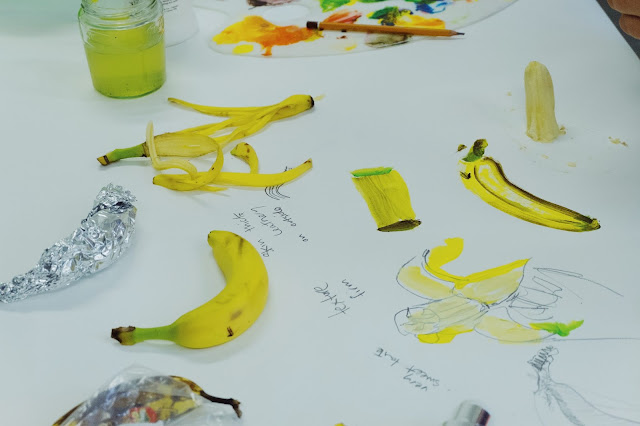Soft Critique (Crit)
 |
| During the crit the students listened to the teacher carefully and took notes |
A soft crit is a discussion during which the creator shares their project, and then others ask about the purpose of the project. The audience inquire about the process of creation, which helps the creators re-organize their design concepts, and promotes the further development as a result.
What’s the difference between the crit and the traditional presentation?
The crit, to a great degree, is distinguished from the a traditional presentation by showing all your personal thinking (even it is unfinished). The audience is expected to offer relevant suggestions depending on their own experiences or feedback through a friendly and open conversation. Thus, you can get abundant and diverse ideas instead of being taught by your tutor directly. It is definitively unlimited!
Before the crit
The repetition and iteration will go on with refining ideas by “primary” and “secondary” research as well as “prototyping” before the crit, so students tend to explore more possibilities of their own thoughts and develop the discussion in more depth. See the notes at the end of this blog post for explanations of the terms. You can also check out the blog post about Bananarama, which talks about primary and secondary research, or another post about the prototyping workshop.
 |
| Research and analysis of “fragment of female-faced pottery plate” |
During the crit
The students expressed their unique perspectives on their objects (see the blog post about the visit to the archives for details). For instance, one group in our class, who analyzed the pottery fragment related to ancient Egyptian culture, subverted it to the head-wear which resembled a wig, a classic epitome of Egyptian literature and art. However, they altered the material from the heavy one to an elaborate accessory. It was well-commended by tutors and classmates who praised the process of transforming the old object into something new.
All the projects were amazing: some re-defined the ice-cream embroidery to the lighting device, focusing on the meaning of color in postmodernism related with the over-decorated culture, and even connecting the memories of childhood for adults; some used the strips of ancient China’s sleeve to discuss the hidden art in olden days; some examined the old GSA metal box for the application in the chess game that was associated with Glasgow’s memories; some investigated the fabric containing the memory of the GSA fire disaster.
With all the sharing in class, the students got plentiful suggestions and links to related sources, strengthening their further prototyping.
 |
| Design inspiration (from the left): “Blue pottery fragment”, “Chinese sleeve strips” and “GSA metal box” |
Inspiration from soft crit
The group who observed the pottery fragment said that they found another material – wire, to evaluate the flexibility and to shape their accessories, which enhanced the contrast between Chinese traditional culture and Egyptian culture; the group who developed ice-cream embroidery said that that crit inspired them to preserve the sentimental objects in the box.
John, the workshop tutor, mentioned that the value of an object could be changing during the periods, which encouraged the students to further their imagination.
What we learned from the soft crit?
The students said that the crit helped them to find deeper information may have been ignored initially, and another important thing was using the materials more precisely. Material could play a significant role in reflecting designer’s intention. Even more, the designer does not need to find the exquisite material to demonstrate their ideas, but to find the appropriate material in daily life which is normal, useful, and tactile, evaluating the strength of material and appraising the unexpected effect.
Moreover, the most important part was that we had learnt plentiful relevant knowledge in the aspects of history, culture and art; for example, the artist Joesph Cornell’s original style which incorporated abandoned and discarded artifacts. That is the reason why the crit encouraged us to understand the theory in more depth to support our research and making.
 |
| Students' comments on the crit |
Notes
Primary research: observing and doing physical analysis on the object.
Secondary research: searching in the books or on the internet for related information.
Prototyping: evaluating ideas immediately and directly.
***
This blog post was written by Yu-Ching Peng and Yu-Jia Zhu, and edited by their classmates and tutors. The photos were taken by the authors with the permission from the persons in the images.
Yu-Ching comes from Taiwan while Yu-Jia is from China. At GSA, both of them are going to study on the MDes Interior Design programme. When asked about their mottos, Yu-Ching said 'I can do this all day' and Yu-Jia confessed 'I know that I am imperfect, and I embrace it'.
***
Many thanks to the studio tutors, Kaitlyn and John, for their patience and insightful feedback during the crit.


Comments
Post a Comment